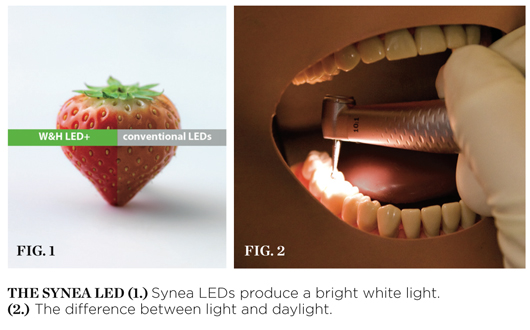A-dec|W&H Synea LED
Bringing a new level of competence to meet and exceed dentists' handpiece requirements.
Over the decades, the dental handpiece has evolved to assist dentists in meeting the treatment needs of their patients. But handpieces are more than just drills, and the benefits of a well-designed handpiece go far beyond its ability to cut tooth enamel. Vision, power, and ergonomics dominate the top requirements for a high-speed handpiece. The newest Synea Highspeed LEDs from A-dec|W&H bring a new level of competence to meet and exceed those requirements.
Vision: The Difference between Light and Daylight
Since the late 1970s, the miniature halogen bulb has been the lighting standard for handpieces. Halogen provides a very good color-rendering index (CRI), but the light emission has a yellowish tint due to low color temperature (CCT) and the bulb has a very short life span. These were all problems that W&H solved using LEDs (light-emitting diodes). Although not new technology, LEDs are new to dental handpieces, and in 2007 W&H was the first to design this light technology into their product line. The implementation of LEDs into the Synea highspeeds was so well thought-out that it remains the superior handpiece lighting design in the industry and the first with sterilizable LEDs.
Synea LEDs produce a radiation spectrum of light that mimics daylight (5,500 K) with incredible accuracy and is free of any color tint. To improve the LED color-rendering index, W&H adjusts the LEDs to produce neutral white light (Figure 1). This ensures that all color information for dental applications appears correct and with exceptional quality. Since LED lights last 10 times longer than halogens, the quality and longevity make this the preferred light for handpieces.1
In the past, bulbs placed in the lower region of the handpiece transmitted light to the oral cavity through optical fibers. This significantly reduced the efficiency of the light, both because of degradation in the fibers due to sterilization and in the narrow focus of the light beam in the oral cavity. In contrast, Synea LEDs are located on the head of the handpiece, just below the bur. The result is effusive lighting of the oral cavity with the brightness of daylight (Figure 2). The working and adjacent tooth surfaces are presented in complete clarity with minimal shadows. Since W&H's third-generation LED technology is completely sterilizable and experiences no degradation in light quality during its lifetime, the advantage over halogen lights is significant.
Knowing how important it is for handpiece lighting to be consistent, W&H integrated an electric ballast into Synea handpieces. This system allows the precisely defined LED light quality to be reproduced exactly, regardless of the delivery system or voltage setting in which it operates. The luminous intensity of 25,000 lux never changes and the customer does not need to make adjustments.
Power: In Some Cases, Smaller is Better
Synea handpieces uniquely solve the problem of space versus power in the oral cavity. The TA-97 LED, with a mini-head size of 10 mm in diameter and push-button chuck, delivers 17 W of power and accommodates bur lengths from 16 mm to 21 mm, maximizing the dentist's access and vision in the oral cavity. At a slightly larger 11.5-mm diameter, the TA-98 LED delivers more than 20 W of power. Both handpieces are so precisely engineered that even with all that power they are two of the quietest handpieces in the market at 59 dBA and 57 dBA, respectively. Quicker, quieter preparations with a clear line of sight help dentists to deliver superior and more comfortable care for their patients.
Cool: In a Wet Sort of Way
Doctors have two concerns when it comes to spraying the treatment area with air and water. The first is to ensure that the tooth stays cool to prevent the pulp from overheating. Second, spraying must improve visibility by clearing away the tooth debris. For these reasons, W&H developed the unique Penta Spray (five-port) cooling system in their Synea highspeeds. Penta Spray's cyclonic action effectively disperses tooth debris, providing clear visibility for the dentist. With five ports of water coolant spray, the dentist is assured a cool, more efficient operation of their handpiece, as well as less heat transmission to the tooth from the bur. And, with five ports, even if the neighboring tooth is in the way or one port is plugged, the remaining ports provide sufficient cooling.
Light: Easy on the Hands
No one works well when they are fatigued. That is exactly why W&H has conducted extensive research and testing to create the lightest ergonomic handpiece system in the industry. Synea highspeeds and their accompanying swivel connectors prevent tubing and handpiece position from creating tension in the hand. The matte stainless-steel finish and distinctive elliptical grip allow a firm, safe, and comfortable hold on the handpiece, while the ergonomic shape lets the dentist practice with more precision, greater relaxation, and less fatigue.
Conclusion
For more than 17 years, A-dec has partnered with W&H to bring precision handpieces to doctors in North America. W&H's passion for promoting the success of dentists and elevating care for patients is a perfect reflection of A-dec's passion and values for manufacturing dental equipment. Synea highspeed LEDs fulfill that passion by providing superior vision, performance, and overall comfort for both the dentist and the patient.
For more information, contact:
A-dec|W&H
Phone: 800-547-1883
Web: https://www.a-dec.com
References
1. W&H website. Available at https://www.wh.com/en_global/newsroom/whnews/archive/24099/index.aspx.
Disclaimer
The preceding material was provided by the manufacturer. The statements and opinions contained therein are solely those of the manufacturer and not of the editors, publisher, or the Editorial Board of Inside Dentistry. The preceding is not a warranty, endorsement, or approval for the aforementioned products or services or their effectiveness, quality, or safety on the part of Inside Dentistry or AEGIS Communications. The publisher disclaims responsibility for any injury to persons or property resulting from any ideas or products referred to in the preceding material.






